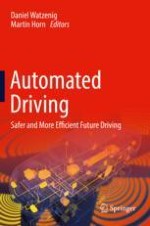2017 | OriginalPaper | Buchkapitel
16. Functional Safety of Automated Driving Systems: Does ISO 26262 Meet the Challenges?
verfasst von : Helmut Martin, Kurt Tschabuschnig, Olof Bridal, Daniel Watzenig
Erschienen in: Automated Driving
Aktivieren Sie unsere intelligente Suche, um passende Fachinhalte oder Patente zu finden.
Wählen Sie Textabschnitte aus um mit Künstlicher Intelligenz passenden Patente zu finden. powered by
Markieren Sie Textabschnitte, um KI-gestützt weitere passende Inhalte zu finden. powered by
